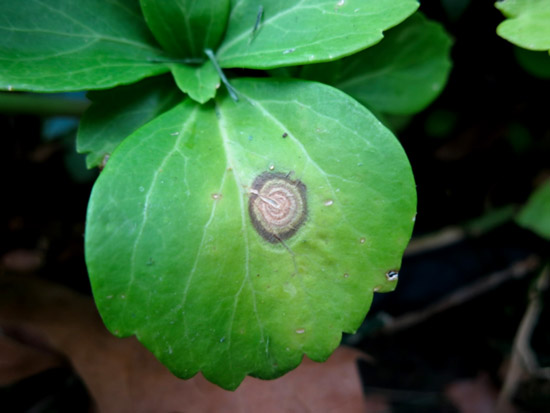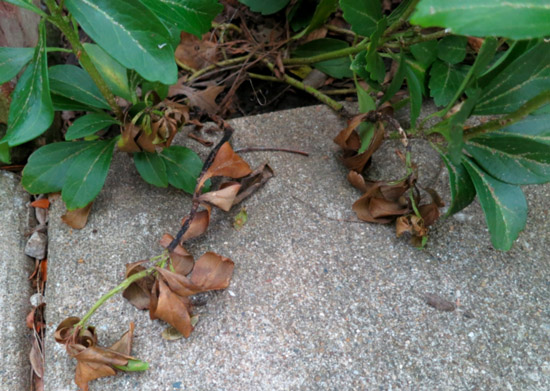Issue 13, August 9, 2013
Pachysandra Leaf and Stem Blight
When sited properly, Japanese pachysandra (Pachysandra terminalis) is considered to be a mostly trouble-free species. However, it occasionally will have problems with scales and a few fungal diseases. Pachysandra leaf and stem blight is the most common disease seen. The disease is caused by the fungal pathogen Volutella pachysandra, which is the disease's imperfect stage. The prefect stage is Pseudonectria pachysandricola.
Common symptoms include:
- Tan leaf spots or blotches with dark brown borders. Concentric rings are often visible within the spots.

Pachysandra leaf blight lesion with concentric rings and dark brown margin - Stems can also be infected resulting in dark brown, expanding cankers. The canker girdles the stem resulting in the death of tissues beyond the infection. Dead stems eventually become withered and shriveled.

Blighted stems and leaves of Japanese Pachysandra, caused by pachysandra stem and leaf blight - Under wet conditions of spring and early summer, pink to orange brown spore pustules are visible on the undersides of affected stems and leaves.
This disease is favored by a weakened or stressed host plant and is often seen on pachysandra damaged by winter injury. Other stresses, such as transplant shock, excess moisture, shearing, scorch from excess sunlight, or scale infestations can also increase a host's susceptibility to the disease. The plants in photo 2 were also infested with Oystershell Scale, likely contributing to the plants susceptibility.
Control options should begin by removing and destroying all severely infected plants. The next step should focus on alleviating any known stresses by controlling scale or other pests, removing accumulated leaf debris that may hold moisture, protecting from excess sunlight or desiccating winter winds. Periodically thinning pachysandra beds will increase air circulation and allow plants to dry off more quickly. Chemical controls should be used as your last option. Fungicides can be used to prevent new infections. Products with the active ingredients chlorothalonil or mancozeb are labeled for homeowner use. Products with chlorothalonil, thiophanate-methyl, mancozeb and copper based active ingredients are labeled for use in Illinois by commercial applicators. (Travis Cleveland)
Author:
Travis Cleveland